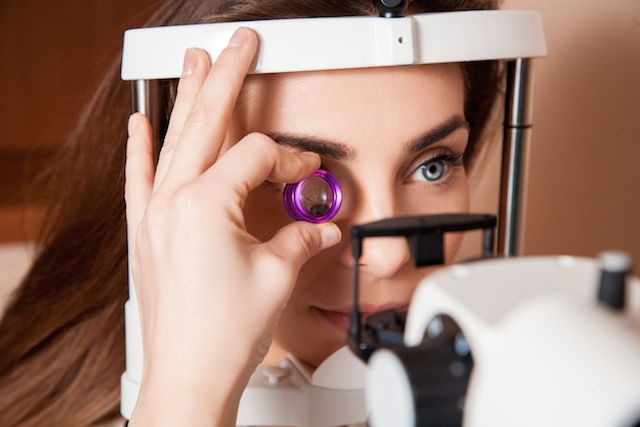Diabetic retinopathy is a complication of diabetes that affects the eyes, causing increased permeability of the blood vessels in the eyes and interfering with vision.
Initially, diabetic retinopathy does not cause any symptoms, and may be discovered on a routine eye exam. Overtime, uncontrolled blood sugar levels can lead to symptoms like gradual loss of vision, blurry vision, dark spots in your vision, partial loss of vision, or irreversible blindness.
Treatment of diabetic retinopathy is managed by both an ophthalmologist and an endocrinologist and involves maintaining adequate blood sugar control through diet, exercise, and the use of medications for diabetes. Complications of diabetic retinopathy, such as macular edema, are treated by an ophthalmologist with intraocular medications.

Common symptoms
The main symptoms of diabetic retinopathy are:
- Difficulty reading or seeing things that are far away;
- Small black dots or lines in your vision;
- Blurry vision;
- Dark spots in your vision, called "floaters";
- Difficulty seeing at night;
- Difficulty distinguishing between different colors.
These symptoms are not always obvious prior to the onset of blindness, which is why it is important for people with diabetes to maintain good blood sugar control and have regular appointments with an ophthalmologist to assess eye health.
Confirming a diagnosis
Diabetic retinopathy is diagnosed by an ophthalmologist based on the results of an eye exam and blood sugar tests, in addition to taking a detailed medical history, such as how long a patient has been diagnosed with diabetes and which diabetes medications they are taking.
A test called fluorescein angiography may also be indicated by your doctor, which provides images of the blood vessels in the retina.
Possible causes
Diabetic retinopathy is caused by uncontrolled diabetes over a long period of time.
This is because high levels of sugar in the blood can cause blockages in the small blood vessels supplying the retina, causing fluid loss or bleeding.
To compensate for these blocked vessels, the eyes develop new blood vessels that do not function properly. These new blood vessels tend to leak and bleed easily, leading to symptoms of diabetic retinopathy.
Main types
Diabetic retinopathy can be divided into two different types:
- Non-proliferative diabetic retinopathy (NPDR): the initial stage of the disease, in which small lesions can be visualized in the blood vessels of the eye;
- Proliferative diabetic retinopathy: the more severe type involving permanent damage to the blood vessels in the eyes and the formation of more fragile vessels that can easily break, leading to worsening vision or blindness.
In order to avoid diabetic retinopathy it is important to adhere to a diabetes treatment plan as advised by your endocrinologist or primary care provider. This includes maintaining a healthy diet, exercising regularly, and monitoring blood sugar levels throughout the day.
Treatment options
Treatment of diabetic retinopathy is managed by an ophthalmologist, in consultation with an endocrinologist, and may vary depending on the severity and type of the disease.
The main treatments of diabetic retinopathy include:
1. Regular follow up
In the case of non-proliferative diabetic retinopathy, a doctor may recommend close follow up without the need for any specific treatment.
Follow up appointments with the ophthalmologist are usually scheduled:
- Once a year, in cases of mild, non-proliferative diabetic retinopathy;
- Every 6 to 12 months in the case of mild-to-moderate non-proliferative diabetic retinopathy;
- Every 2 to 4 months for severe or very severe non-proliferative diabetic retinopathy.
Your doctor should also confirm that your diabetes is being adequately treated and that you are taking all of your medications correctly.
In addition, your doctor should also follow up on the results of blood glucose testing in order to prevent progression of diabetic retinopathy.
2. Medications
An ophthalmologist may prescribe certain medications for the treatment of complications of diabetic retinopathy, such as macular edema.
The most common medications used in these cases are vascular endothelial growth factor (VEGF) inhibitors, such as:
- Bevacizumab;
- Ranibizumab;
- Aflibercept;
- Brolucizumab;
- Faricimab.
These medications are administered by an ophthalmologist directly into the eye using local anesthesia, and can help slow down or reverse diabetic retinopathy and improve vision.
These medications work by blocking a protein known as vascular endothelial growth factor that is responsible for causing leaky blood vessels, retinal inflammation, and abnormal growth of blood vessels that can damage the eye.
3. Laser surgery
Laser surgery, called laser photocoagulation surgery, is indicated for more advanced cases of proliferative diabetic retinopathy.
This treatment eliminates the new blood vessels that are forming in the eye and causing vision problems, stopping any bleeding if present.
4. Corticosteroid implants
Extended release corticosteroid implants, like dexamethasone, are administered into the eye by an ophthalmologist to help reduce inflammation and swelling due to macular edema caused by proliferative diabetic retinopathy.
This type of treatment is generally indicated when there is no improvement with the use of VEGF inhibitors. Corticosteroid implants offer long term control of inflammation, however they can cause side effects like ocular hypertension and glaucoma.
5. Vitrectomy
In cases of constant bleeding or significant scarring of the eyes, a doctor may recommend a surgery called a vitrectomy, in which the cloudy vitreous and the sources of bleeding in the retina are repaired.
It is important to maintain good diabetes control, even in cases of non-proliferative diabetic retinopathy, in order to prevent worsening retinopathy as well as other complications such as diabetic foot and heart disease.
Prevention and control
Diabetic retinopathy can be prevented by maintaining good diabetes control. This involves maintaining a well-balanced diet, engaging in regular physical exercise, and taking all diabetes medications as prescribed in order to adequately control blood sugar levels.
People with diabetes should been seen by an ophthalmologist at least once a year to help ensure early detection and treatment of this condition and to prevent complications like macular edema that can lead to partial vision loss or irreversible blindness, which typically effects both eyes.
Also recommended: Diabetic Diet: What to Eat & Avoid (with Meal Plan) tuasaude.com/en/diabetic-diet




























